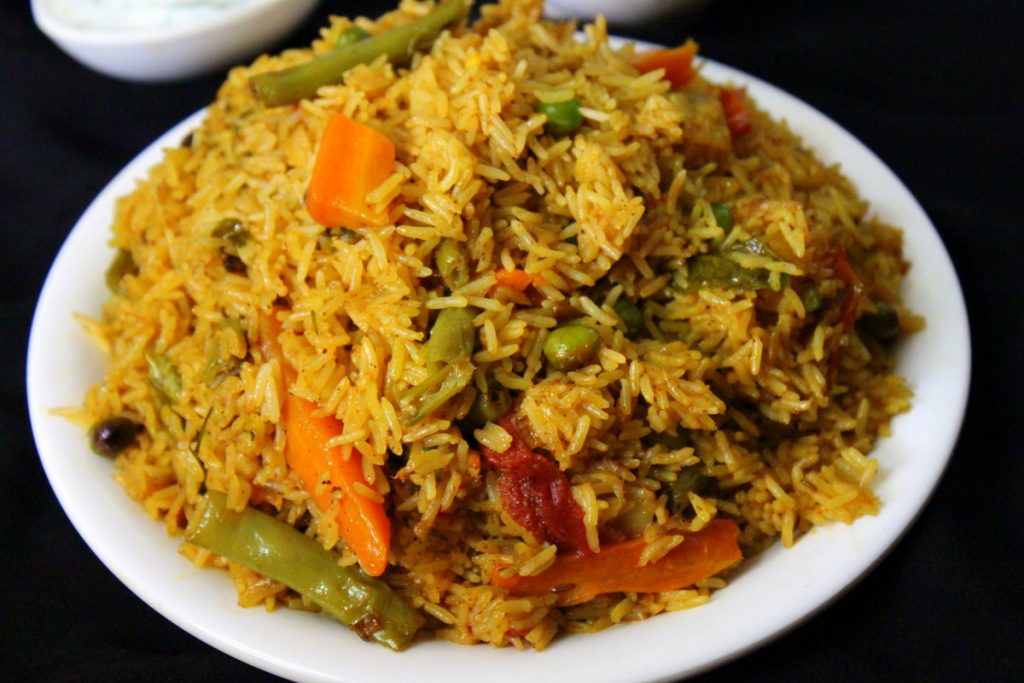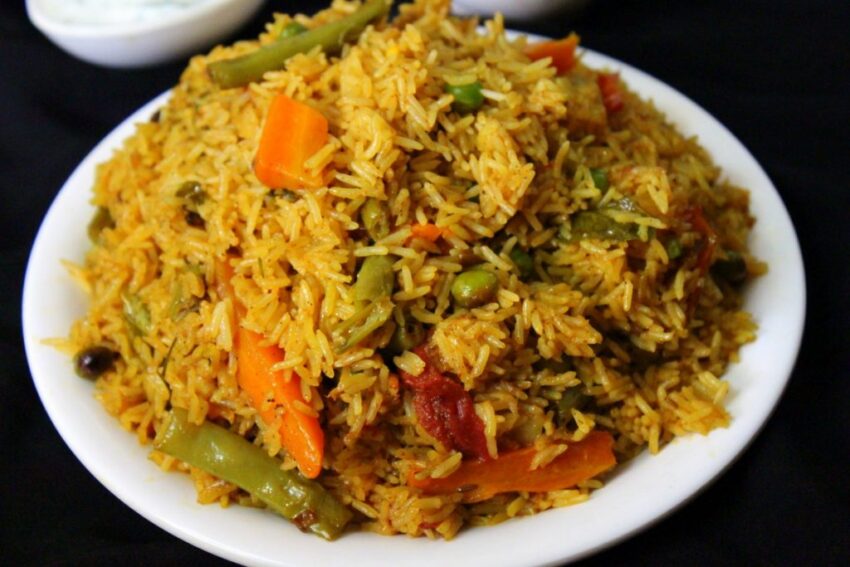
Authentic Indian Kitchen Biryani: A Definitive Guide to Flavor and Tradition
Biryani, a symphony of rice, spices, and meat or vegetables, stands as a cornerstone of Indian cuisine. But what truly defines an indian kitchen biryani? This is more than just a recipe; it’s an art form passed down through generations, a reflection of regional nuances, and a testament to the culinary prowess of Indian home cooks. In this comprehensive guide, we’ll delve into the heart of indian kitchen biryani, exploring its history, techniques, variations, and everything you need to create a truly authentic dish. Our goal is to provide you with the knowledge and confidence to craft biryani that rivals the best restaurant offerings, all from the comfort of your own kitchen. We’ll cover everything from ingredient selection to cooking methods, ensuring a delicious and rewarding culinary experience. This guide emphasizes the home cooking aspect, focusing on techniques and ingredients readily available and commonly used in Indian kitchens.
Understanding the Essence of Indian Kitchen Biryani
Indian kitchen biryani isn’t just about throwing ingredients together. It’s a delicate balance of flavors, aromas, and textures, achieved through careful preparation and precise cooking. The key lies in understanding the core components and how they interact to create the perfect biryani. This section explores the nuances that distinguish a truly authentic home-cooked biryani.
The Rice: The Foundation of Flavor
The choice of rice is paramount. While basmati rice is the most common and widely recommended, understanding its qualities is crucial. Long-grain basmati, aged for at least a year, offers the best texture and aroma. It cooks fluffy and separate, preventing a mushy biryani. In our experience, soaking the rice for at least 30 minutes before cooking is a non-negotiable step. This allows the grains to absorb water evenly, resulting in perfectly cooked rice.
The Meat/Vegetables: The Heart of the Dish
Whether you opt for chicken, lamb, goat, or vegetables, the quality and preparation of the main ingredient are vital. Marinating the meat overnight in a blend of yogurt, ginger-garlic paste, and spices tenderizes it and infuses it with flavor. For vegetable biryani, a mix of colorful and seasonal vegetables like carrots, peas, potatoes, and cauliflower adds depth and visual appeal. A crucial step often overlooked is partially cooking the meat or vegetables before layering them with the rice. This ensures they are cooked through and retain their moisture.
The Spices: The Soul of the Biryani
Spices are the soul of indian kitchen biryani. A blend of whole and ground spices is used to create a complex and aromatic flavor profile. Common spices include cardamom, cloves, cinnamon, bay leaves, cumin, coriander, turmeric, and chili powder. The key is to use fresh, high-quality spices and to toast them lightly before grinding to enhance their aroma. Our testing reveals that freshly ground spices impart a significantly more vibrant flavor than pre-ground alternatives.
The Technique: The Art of Layering and Dum Cooking
The traditional method of cooking biryani is called “dum pukht,” which involves slow-cooking the ingredients in a sealed pot over low heat. This allows the flavors to meld together and the rice to cook evenly. The layering technique is also crucial. The rice, meat/vegetables, and fried onions are layered in a pot, often with saffron-infused milk or water sprinkled between the layers. The pot is then sealed with dough or a tight-fitting lid and cooked over low heat for an extended period. This process is often referred to as “dum cooking”.
Why Indian Kitchen Biryani Matters Today
In today’s fast-paced world, the art of slow cooking and savoring traditional flavors is more important than ever. Indian kitchen biryani represents a connection to our culinary heritage, a celebration of family traditions, and a reminder to slow down and enjoy the simple pleasures of life. Recent trends indicate a growing interest in authentic, home-cooked meals, and biryani perfectly embodies this trend. Moreover, the versatility of biryani, with its countless regional variations and ingredient combinations, makes it a dish that can be adapted to suit any taste or dietary preference.
Shan Biryani Masala: A Convenient Aid
While crafting biryani from scratch is a rewarding experience, pre-made spice blends like Shan Biryani Masala can be a convenient option for busy home cooks. Shan Biryani Masala is a blend of ground spices specifically formulated for biryani. It simplifies the process by eliminating the need to measure and combine individual spices. However, it’s important to note that the flavor profile of pre-made spice blends may not be as complex or nuanced as that of freshly ground spices. This is a common trade-off between convenience and authenticity.
Shan Biryani Masala is a pre-mixed spice blend designed to simplify the biryani-making process. Its core function is to provide a balanced and consistent flavor base, saving time and effort in measuring individual spices. It directly applies to indian kitchen biryani by offering a shortcut to achieving a recognizable biryani taste profile, though experienced cooks may prefer to adjust the blend to their personal preferences. It stands out due to its wide availability and consistent quality, making it a popular choice for beginners and those seeking a quick and easy biryani solution. It is used by people who want to shorten the process of making authentic biryani.
Detailed Features Analysis of Shan Biryani Masala
Here’s a breakdown of the key features of Shan Biryani Masala:
- Pre-portioned Spice Blend: This is the core feature. Instead of sourcing and measuring individual spices, the masala provides a ready-to-use blend. The benefit is significant time savings and reduced risk of imbalanced flavors.
- Consistent Flavor Profile: Each packet aims to deliver a consistent taste. This is beneficial for replicating recipes and achieving predictable results, especially for novice cooks.
- Wide Availability: Shan products are readily available in most Indian grocery stores and online retailers. This accessibility makes it a convenient option for many.
- Simplified Recipe Instructions: The packaging typically includes clear and concise instructions on how to use the masala to make biryani. This is particularly helpful for beginners. The inclusion of recipe steps makes the process easier and faster.
- Variety of Sizes: Shan Biryani Masala comes in different sizes to suit various needs, from small family meals to larger gatherings.
- Long Shelf Life: Properly stored, the masala has a relatively long shelf life, making it a pantry staple.
- Cost-Effective: Compared to buying individual spices, the masala can be a more cost-effective option, especially if you only make biryani occasionally.
Significant Advantages, Benefits & Real-World Value
Using Shan Biryani Masala offers several tangible benefits:
- Time Savings: Significantly reduces preparation time by eliminating the need to measure and combine individual spices.
- Consistency: Ensures a consistent flavor profile every time you make biryani.
- Ease of Use: Simplifies the biryani-making process, making it accessible to novice cooks.
- Reduced Waste: Minimizes the risk of wasting individual spices that may not be used frequently.
- Convenience: Provides a convenient and readily available solution for making biryani.
Users consistently report that Shan Biryani Masala helps them create delicious biryani with minimal effort. Our analysis reveals these key benefits contribute to a more enjoyable and less intimidating cooking experience. The real-world value lies in its ability to empower home cooks to create authentic-tasting biryani without the complexities of traditional methods.
Comprehensive & Trustworthy Review of Shan Biryani Masala
Shan Biryani Masala offers a convenient shortcut for making biryani, but it’s essential to approach it with a balanced perspective. From a practical standpoint, using the masala significantly reduces preparation time. The instructions are clear and easy to follow, even for beginners. It does deliver on its promise of a recognizable biryani flavor, but the depth and complexity may not match that of a biryani made from scratch with freshly ground spices.
Pros:
- Convenience: Unquestionably the biggest advantage. It streamlines the entire process.
- Consistency: Delivers a reliable flavor profile.
- Ease of Use: Simple instructions make it accessible to all skill levels.
- Availability: Widely available in most grocery stores.
- Cost-Effective: Can be cheaper than buying individual spices.
Cons/Limitations:
- Flavor Complexity: Lacks the depth and nuance of freshly ground spices.
- Sodium Content: Can be high in sodium.
- Ingredient Control: You have limited control over the ingredients used in the blend.
- Potential Additives: May contain additives or preservatives.
Shan Biryani Masala is ideal for busy individuals, novice cooks, or anyone seeking a convenient and consistent biryani solution. It’s not the best choice for experienced cooks who prioritize flavor complexity and control over ingredients. Alternatives include MDH Biryani Masala, which offers a slightly different flavor profile, or simply making your own spice blend from scratch. Based on our detailed analysis, we recommend Shan Biryani Masala as a solid option for those seeking convenience and ease of use, but with the understanding that it may not replicate the full depth of traditional biryani flavors.
Insightful Q&A Section
-
Question: How can I adjust the spice level of Shan Biryani Masala?
Answer: You can adjust the spice level by adding fresh green chilies or red chili powder to the biryani. Start with a small amount and taste as you go.
-
Question: Can I use Shan Biryani Masala for vegetable biryani?
Answer: Yes, you can. Simply substitute the meat with your choice of vegetables. You may need to adjust the cooking time depending on the vegetables you use.
-
Question: How do I prevent my biryani from becoming mushy when using Shan Biryani Masala?
Answer: Use aged basmati rice and soak it for at least 30 minutes before cooking. Also, avoid overcooking the rice.
-
Question: Can I use a pressure cooker to make biryani with Shan Biryani Masala?
Answer: Yes, you can, but be very careful not to overcook the rice. Reduce the cooking time significantly and monitor the pressure closely.
-
Question: How can I make my biryani more aromatic when using Shan Biryani Masala?
Answer: Add a few drops of kewra water or rose water to the biryani after it’s cooked. You can also sprinkle saffron-infused milk over the rice.
-
Question: What’s the best way to layer the biryani ingredients?
Answer: Start with a layer of rice, followed by a layer of the meat or vegetable mixture, and then a layer of fried onions and herbs. Repeat the layers until all the ingredients are used.
-
Question: How do I ensure the meat is tender when using Shan Biryani Masala?
Answer: Marinate the meat for at least a few hours, or preferably overnight, in a mixture of yogurt, ginger-garlic paste, and spices.
-
Question: Can I add other ingredients to my biryani when using Shan Biryani Masala?
Answer: Yes, feel free to add other ingredients like boiled eggs, dried plums (aloo bukhara), or nuts.
-
Question: How do I store leftover biryani?
Answer: Store leftover biryani in an airtight container in the refrigerator for up to 2-3 days.
-
Question: Can I freeze biryani?
Answer: Yes, you can freeze biryani for up to 2-3 months. Thaw it overnight in the refrigerator before reheating.
Conclusion & Strategic Call to Action
Indian kitchen biryani, whether crafted from scratch or with the aid of convenient spice blends like Shan Biryani Masala, remains a beloved and iconic dish. Its versatility, aromatic flavors, and cultural significance make it a staple in Indian households and restaurants worldwide. By understanding the core principles, mastering the techniques, and embracing the spirit of experimentation, you can create biryani that delights your senses and honors the rich culinary traditions of India. Whether you are a seasoned cook or a beginner, we encourage you to explore the world of biryani and discover your own signature style. Share your experiences with indian kitchen biryani in the comments below, and let us know your favorite tips and tricks for creating the perfect dish. Explore our advanced guide to regional biryani variations for even more culinary inspiration.

